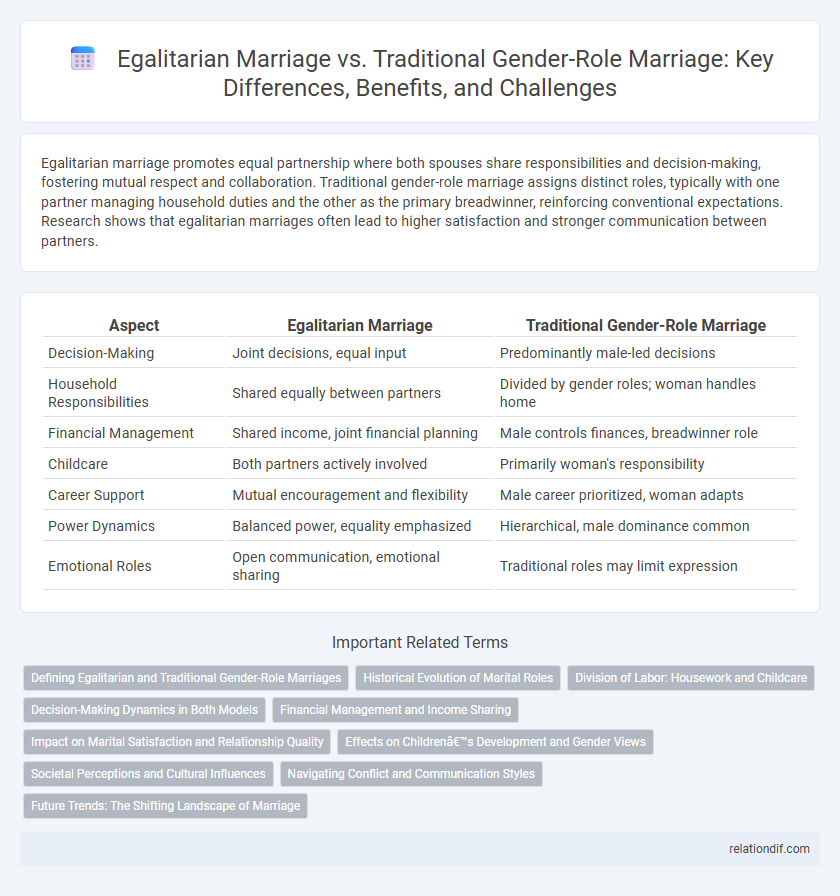Egalitarian marriage promotes equal partnership where both spouses share responsibilities and decision-making, fostering mutual respect and collaboration. Traditional gender-role marriage assigns distinct roles, typically with one partner managing household duties and the other as the primary breadwinner, reinforcing conventional expectations. Research shows that egalitarian marriages often lead to higher satisfaction and stronger communication between partners.
Table of Comparison
| Aspect | Egalitarian Marriage | Traditional Gender-Role Marriage |
|---|---|---|
| Decision-Making | Joint decisions, equal input | Predominantly male-led decisions |
| Household Responsibilities | Shared equally between partners | Divided by gender roles; woman handles home |
| Financial Management | Shared income, joint financial planning | Male controls finances, breadwinner role |
| Childcare | Both partners actively involved | Primarily woman's responsibility |
| Career Support | Mutual encouragement and flexibility | Male career prioritized, woman adapts |
| Power Dynamics | Balanced power, equality emphasized | Hierarchical, male dominance common |
| Emotional Roles | Open communication, emotional sharing | Traditional roles may limit expression |
Defining Egalitarian and Traditional Gender-Role Marriages
Egalitarian marriages emphasize equal power, responsibilities, and decision-making between partners, promoting shared roles in both domestic and professional spheres. Traditional gender-role marriages assign distinct roles based on cultural or societal expectations, with one partner typically responsible for income generation and the other for household management. Research shows that egalitarian marriages often report higher relationship satisfaction and improved communication compared to traditional gender-role marriages.
Historical Evolution of Marital Roles
Marital roles have evolved significantly from rigid traditional gender norms, where men were primary breadwinners and women managed household duties, to more egalitarian arrangements emphasizing shared responsibilities and decision-making. Historical shifts in economic structures, women's labor force participation, and changing cultural attitudes have driven the transformation toward partnerships based on equality and mutual support. This evolution reflects broader social movements advocating gender equality and the redefinition of marital expectations in contemporary society.
Division of Labor: Housework and Childcare
Egalitarian marriages emphasize an equal division of housework and childcare, with both partners sharing responsibilities based on skills and preferences rather than gender. In contrast, traditional gender-role marriages often allocate domestic duties according to societal expectations, where women primarily handle childcare and household chores while men focus on financial provision. Research shows that egalitarian couples experience higher relationship satisfaction and more effective teamwork in managing family tasks.
Decision-Making Dynamics in Both Models
Egalitarian marriages feature shared decision-making where both partners contribute equally to choices regarding finances, household responsibilities, and parenting, promoting mutual respect and collaboration. Traditional gender-role marriages often delegate decisions based on established roles, with males typically holding primary authority in financial and major life decisions while females manage domestic and caregiving responsibilities. Studies show egalitarian couples report higher satisfaction due to balanced influence, whereas traditional models may face conflict from power imbalances and unmet expectations.
Financial Management and Income Sharing
Egalitarian marriages typically involve joint financial management where both partners share income equally and participate in budgeting, fostering mutual accountability and transparency. Traditional gender-role marriages often designate financial control predominantly to one partner, usually the male, which can limit the other partner's financial autonomy and decision-making power. Studies show that egalitarian income sharing correlates with higher relationship satisfaction and financial stability, as resources and responsibilities are more evenly distributed.
Impact on Marital Satisfaction and Relationship Quality
Egalitarian marriages, characterized by shared responsibilities and mutual decision-making, consistently show higher marital satisfaction and improved relationship quality compared to traditional gender-role marriages. Research indicates that couples in egalitarian relationships experience better communication, emotional support, and conflict resolution, leading to greater overall happiness. Conversely, traditional gender-role marriages often face challenges due to rigid expectations, which may result in decreased satisfaction and increased relational stress.
Effects on Children’s Development and Gender Views
Egalitarian marriages, where both parents share roles and responsibilities equally, foster children's development by promoting gender equality and flexible role models, enhancing emotional intelligence and cognitive skills. In contrast, traditional gender-role marriages often reinforce stereotypical gender views, limiting children's perceptions of their potential and reinforcing rigid social norms. Research shows children from egalitarian households tend to exhibit more progressive attitudes toward gender roles and demonstrate greater adaptability in social settings.
Societal Perceptions and Cultural Influences
Egalitarian marriages, characterized by equal power distribution and shared responsibilities, challenge traditional gender-role marriages often rooted in cultural norms emphasizing male authority and female domesticity. Societal perceptions increasingly favor egalitarian partnerships for promoting gender equality and mutual respect, though cultural influences in various regions continue to uphold traditional roles through family expectations and social conditioning. Studies indicate that exposure to progressive values and education correlates with greater acceptance of egalitarian marriages, highlighting the tension between evolving social attitudes and enduring cultural traditions.
Navigating Conflict and Communication Styles
Egalitarian marriages prioritize open dialogue and shared decision-making, fostering conflict resolution through mutual respect and collaboration. Traditional gender-role marriages often rely on established roles where communication may be influenced by hierarchical dynamics, potentially limiting emotional expression and negotiation. Navigating conflict in egalitarian partnerships benefits from balanced power and active listening, whereas traditional models may require addressing entrenched role expectations to improve communication effectiveness.
Future Trends: The Shifting Landscape of Marriage
Egalitarian marriage models increasingly dominate future marriage trends, emphasizing shared responsibilities and decision-making between partners. Traditional gender-role marriages, while still present, face declining prevalence due to evolving societal values around equality and individual autonomy. Research indicates younger generations prioritize flexibility in roles, predicting a continued shift toward egalitarian dynamics in global marital landscapes.
egalitarian marriage vs traditional gender-role marriage Infographic

 relationdif.com
relationdif.com